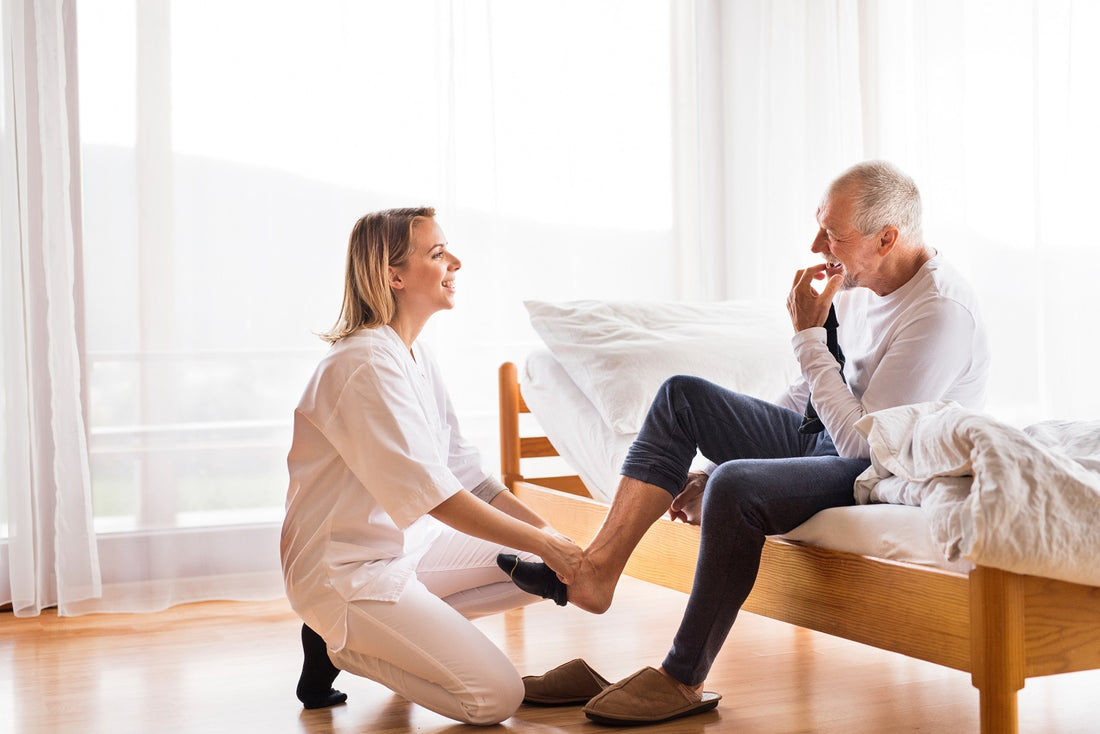Introduction
As we age, maintaining good circulation, mobility, and joint health becomes increasingly important. For seniors, compression socks are a simple yet effective way to address common health concerns, providing comfort, support, and improved circulation. Whether for daily wear or during long periods of sitting or standing, compression socks offer a range of health benefits that can make a real difference in a senior’s quality of life.

1. Improved Blood Circulation
How It Helps: Poor circulation is a common issue for many seniors, often leading to discomfort, swelling, or even more serious conditions like deep vein thrombosis (DVT). Compression socks help by gently squeezing the legs to encourage blood flow, preventing blood from pooling in the lower legs and feet. This circulation boost reduces the risk of clots and improves overall cardiovascular health, making it particularly beneficial for seniors who spend extended periods sitting or lying down.

2. Reduced Swelling and Edema
How It Helps: Swelling, especially in the lower legs, ankles, and feet, can be uncomfortable and even painful. For seniors, this swelling—known as edema—can be caused by long periods of sitting, certain medications, or underlying health conditions. Compression socks help reduce this swelling by applying gentle pressure that encourages the movement of fluids away from the affected areas. This can provide significant relief from tightness, soreness, and discomfort, allowing seniors to move more freely and comfortably.

3. Alleviation of Pain and Discomfort
How It Helps: For seniors with arthritis, varicose veins, or muscle soreness, compression socks can offer welcome relief. The supportive compression reduces the aching, throbbing, and cramping sensations that often accompany these conditions. By promoting better circulation and reducing muscle fatigue, compression socks help seniors stay active and comfortable throughout the day. For those who enjoy walking, exercising, or simply standing for longer periods, this pain relief can be a game-changer.

4. Enhanced Stability and Reduced Risk of Falls
How It Helps: Falls are a major concern for seniors, often resulting in injuries that can lead to long recovery times. Compression socks can improve stability by offering firm support around the lower leg muscles, promoting a steadier gait and enhancing balance. This support helps seniors feel more confident when walking, reducing the likelihood of falls caused by muscle fatigue or instability.

5. Prevention of Varicose Veins
How It Helps: Varicose veins are often a source of discomfort and self-consciousness for seniors, and they can worsen with age. Compression socks help prevent the formation of varicose veins by promoting steady blood flow and reducing the pressure on veins in the legs. For seniors already dealing with varicose veins, compression socks can reduce the associated swelling and pain, improving both comfort and appearance.

Choosing the Right Compression Level for Seniors
Compression socks come in various levels of pressure, measured in millimeters of mercury (mmHg). The best compression level depends on an individual’s health needs and activity level. Here’s a quick guide to help choose the right compression level for seniors:
1. Mild Compression (8-15 mmHg)
- Best For: General comfort, mild swelling, and preventive use.
- Benefits: Provides gentle pressure that can improve circulation and prevent minor swelling. Ideal for seniors who are generally healthy but spend long periods sitting or standing.
- Common Uses: Daily wear, light support, and travel.
2. Moderate Compression (15-20 mmHg)
- Best For: Mild to moderate swelling, varicose veins, and tired legs.
- Benefits: Offers slightly firmer support to alleviate moderate swelling, fatigue, and mild varicose veins. This level is often suitable for seniors who want a balance between support and comfort.
- Common Uses: Swelling control, varicose vein relief, and light circulation support.
3. Firm Compression (20-30 mmHg)
- Best For: Managing more significant swelling, varicose veins, and mild to moderate venous insufficiency.
- Benefits: Provides effective compression for those with more noticeable swelling, varicose veins, or circulation issues. Seniors with these conditions can benefit from the additional support, though a healthcare provider's guidance is recommended.
- Common Uses: Medical support for edema, post-surgery recovery, and certain medical conditions.
4. Extra-Firm Compression (30-40 mmHg and above)
- Best For: Severe swelling, advanced varicose veins, and chronic venous insufficiency.
- Benefits: Provides the strongest compression, generally only recommended for specific medical conditions under professional guidance. Seniors should only use this level if prescribed by a healthcare provider.
- Common Uses: Chronic venous disorders, severe edema, and certain vascular conditions.
Note: Most seniors benefit from mild to moderate compression levels (8-15 mmHg or 15-20 mmHg) for daily comfort and circulation support. If higher compression levels are needed, it's always best to consult a healthcare provider.
Conclusion
Compression socks are a simple yet powerful tool for seniors looking to improve their comfort, mobility, and overall health. From enhanced circulation to better balance and reduced swelling, the benefits are clear. Choosing the right compression level is essential—mild compression is often best for daily wear, while higher compression levels may be recommended for specific health concerns. With consistent use, compression socks can make a meaningful difference in quality of life for seniors, helping them stay active, comfortable, and healthy.

